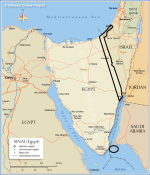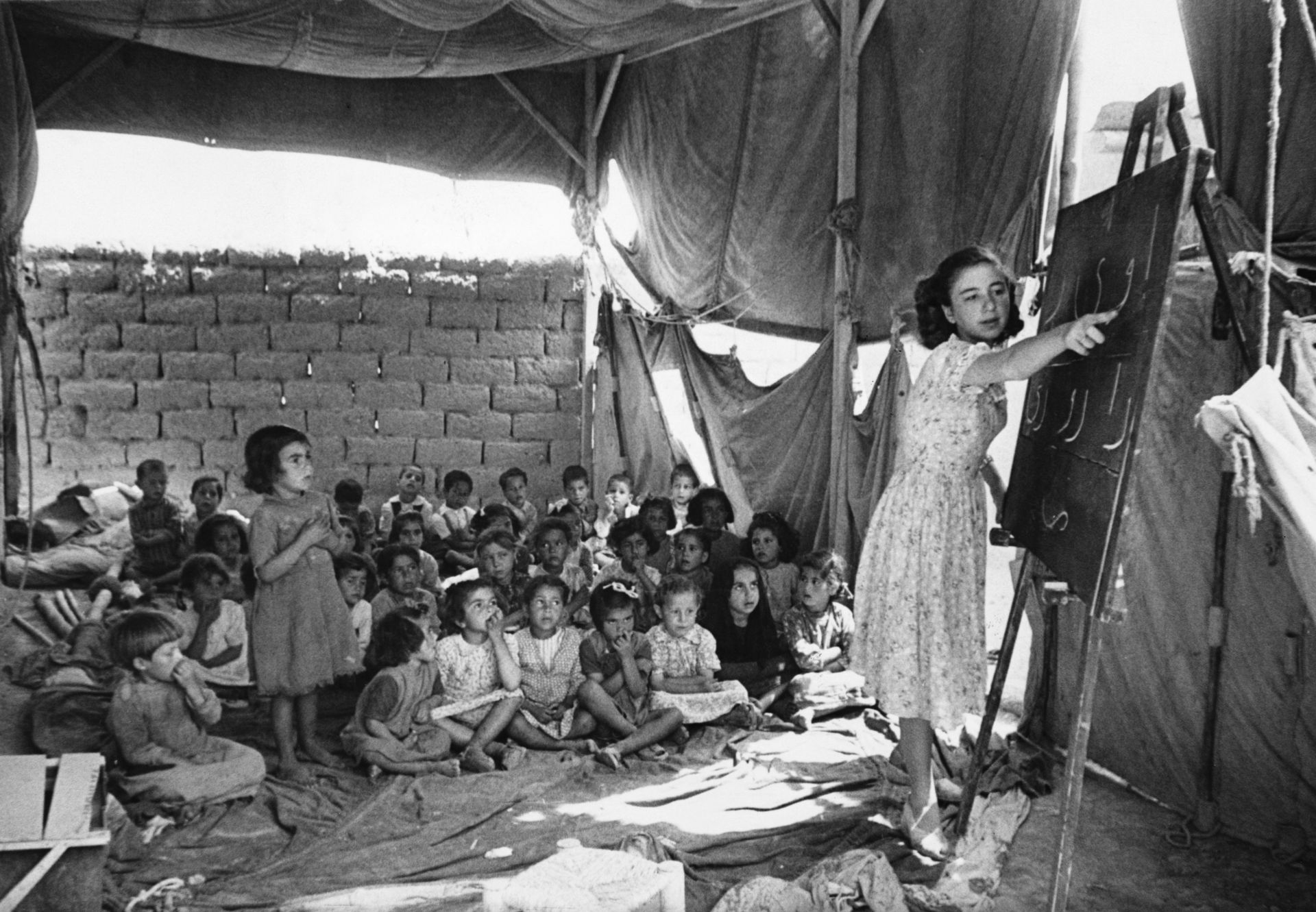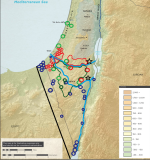So a couple thoughts.
First, the 15 kilometer zone includes the location of OTL Yamit.
At Yamit, the Israelis considered a Mediterranean-Dead Sea Canal (Med-Dead Canal). The Dead Sea is below sea level, and the idea of using the natural elevation difference as a means to generate electricity has been around for a while. Meanwhile, the idea of a Med-Dead Canal extends back to 1855 and even popped up in Herzl's novel. But if not Yamit, the Besor Stream (Wadi Gaza) also floods seasonally and could be the basis for a canal. There is the Nahal Gerar which could be connected to the Nahal Beersheba and from there extended east to the Dead Sea.
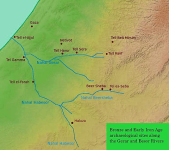
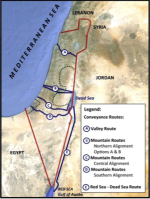
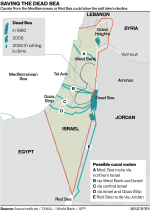

There's also the prospect of the Ben Gurion Canal, which could complement the Med-Dead Canal and which would be shorter in length if Wadi Gaza is used.
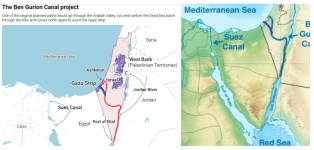
A problem the Israelis would have (like OTL) is what to do with the refugees. Even Egypt in the 50s was interested in resettling some in El Arish and North Sinai. The US and UNRWA were both interested in funding these sort of developmental efforts too.
While Israel as always interested in simply encouraging refugees (as opposed to the original Gazans) to move abroad (and, to be frank, many countries were interested in assisting - such as the USA, Canada, Brazil, Paraguay, etc. - apparently as many as 40 countries were interested after 1967), the Gazans themselves were somewhat resistant to resettlement. Nasser's attempt at resettlement in Sinai for example was met with much resistance. The Israelis seemed generally unwilling to
force people out directly though; although many OTL did emigrate simply because their UNRWA benefits were cut off once Israel took over.
But the Israelis proposed a range of solutions for what to do with Gaza's cramped refugees after 1967. For starters, there were folks in the cabinet who were interested in moving about a quarter to a third of them to the Hebron Region and/or Jordan Valley. But, this met with resistance from Allon who wanted the Jordan Valley for Israeli settlement. El Arish was also floated. The Paraguay scheme of OTL only amount to 17% of Gaza, and even then only a few hundred took the offer. The Israelis until ~1977 seem to have been of the view that they wanted to keep Gaza and settle some of the West Bank, but also expected that they would be returning the West Bank to Jordan and that settlers in the West Bank could just be Jordanian subjects. So the Israeli government seemed to be of the view that
settlement and
sovereignty were different concepts So moving people out of Gaza but to nearby areas was deemed good policy, and the Israelis were trying to reduce the refugee population by such an amount that they could just extend citizenship to who remained afterwards.
Between 1967 and 1968, Israel evicted approximately 75,000 residents of the Gaza Strip who Golda Meir described as a "fifth column". In addition, at least 25,000 Gazan residents were prevented from returning after the 1967 war. The Strip lost 25% of its prewar population between 1967 and 1968. Ideas about emigration seem to have never reached higher than a quarter of Gaza's population of 394,000 people - with bigger figures being focused on moving people other nearby locations like Sinai/El Arish, the West Bank, or Israel itself. Interior Minister Haim Moshe Shapira suggested Israel absorb 200,000 refugees. Yosef Weitz drafted a proposal to settle the refugees in the West Bank - relying upon a different draft plan which would have provided for the settlement of some 250,000 Gaza refugees in the West Bank over ten years at an estimated average annual cost, including housing, job creation, roads, schools, and hospitals, of $50 million. These figures seem to muddle though between the refugee camp
residents (which was the issue Eshkol was really interested in resolving in 1967) who numbered 180,000 at most in 1967 and people who were counted as refugees as a matter of status (which was closer to 250,000) which was considerably higher. If all of this sounds crazy, I'll remind you that the unemployment rate
before 1967 was 55% for men, and
after 1967 it was 74% ... so separate from demographic concerns, the Israelis had a very big problem of unemployed men with nothing to do - which tends to create crime and security issues - and having to care for lots of unemployed people and their families via public assistance.
The decision to settle Gaza was also a close call, with the Israelis being unsure if to go with a "let Gaza be a little Arab autonomy without us around" plan or a "stick settlements in between population centers to prevent the Palestinians from coordinating and causing trouble" view. The latter won out, which was counterproductive, constricting on Palestinian life, and fostered justifiable frustration. But much of the Gaza settlement occurred
after Yamit was dismantled, because Yamit was supposed to be the buffer between Egypt and Gaza. The first settlement
in Gaza, meanwhile, was Gush Katif - on the corner of territory between the Egyptian border and Rafah and due east of Yamit. But the settlement also was in line with a general tendency to rebuild settlements that had been destroyed in 1948, as there had been a Jewish settlement on the same site between 1946 and 1948. Begin meanwhile wanted to just offer citizenship to people who wanted it and to stick Jews
inside of Palestinian cities on the assumption that setting up Jewish quarters would foster good interpersonal relationships. He also supported Sinai resettlement or Jordan resettlement but not West Bank resettlement.
My guess is that the timing in the late 50s makes getting American and UNRWA financing for Negev economic development and Gazan resettlement there a stronger possibility. There is no Fatah yet, as that was founded in 1959 (and as a student group in Kuwait only in 1957) and there is no PLO (founded in 1964). The domestic instability of the 1957 Jordanian Coup Attempt, the 1958 Lebanon Crisis, or the 1958 Iraqi coup has not yet happened; and Nasser would be somewhat discredited by his inability to completely drive the Israelis out of Sinai (and Tiran and Gaza).
And in 1963 the US considered using nuclear weapons to dig an alternative to the Suez Canal through the Israeli desert (meaning there was interest on the US's part in Negev terraforming).
Putting aside the idea of humanitarian emigration (ergo, paying people to move someplace else) the easiest win for the Israelis in resolving the Gaza conundrum is getting outside assistance to develop the Negev and resettling some Gazans in Israel. Others could just be urbanized to Israeli cities. And Gazans could be given access to participate in the Israeli labor market. Nasser had considered moving 60,000 refugees in Gaza to Sinai, so a similar figure in the Negev could make sense.
Here is a piece explaining some context at the time:
The story of a forgotten attempt to resettle Palestinians in the Sinai Peninsula after the 1948 Nakba

newlinesmag.com
Under its second director [in 1951], John B. Blandford, UNRWA moved to resettle hundreds of thousands of Palestinian refugees in Arab states to support large-scale agricultural development — what Blandford called UNRWA’s “new programme” of economic reintegration. Through these projects, UNRWA aimed not only to remove refugees from the agency’s relief rolls but also to launch a wider Arab economic renaissance in line with U.S. strategic interests. The General Assembly supported this effort with a $200 million “Reintegration Fund,” primarily sustained by U.S. contributions. Blandford, a New Yorker with a background in public administration, had held high-level positions in multiple state and federal agencies prior to his arrival at UNRWA. This included the Tennessee Valley Authority (TVA), the preeminent American model for regional economic development.
Continuing
Starting in July 1950, UNRWA worked closely with the Egyptian government to explore agricultural development and resettlement schemes in the Sinai Desert. Initially, extensive surveys of project areas in Sinai had failed to find viable sources of groundwater to support large-scale agriculture. But after the July 1952 coup in Egypt, which brought the nationalist Free Officers to power, plans for Sinai development took a new turn.
The new Egyptian government had independently begun to examine the idea of reclaiming an agricultural zone in Sinai, which would support 60,000 Palestinian refugees resettled from Gaza. To do so, freshwater from the Nile would be conveyed eastward from Cairo through subsidiary canals, siphoned under the Suez Canal, and pumped to an elevated area of nearly 52,000 acres. Blandford and UNRWA officials were excited by this new initiative and, in June 1953, UNRWA had agreed to reserve $30 million of the Reintegration Fund for the siphon scheme. Survey plans were quickly assembled and, at the end of the year, Egyptian, American and Australian land reclamation experts ventured into the desert.
In the context of the new government’s wider commitment to agricultural development, Egypt’s interest in resettling Palestinian refugees in Sinai makes sense. The Egyptian Free Officers were much more concerned with immediate issues of governance — expelling the British from Egypt and fighting against widespread poverty and disease — than championing Palestinian rights. The promise of land reclamation to transform idle deserts and swamps into arable land, resettle populations from overcrowded areas and increase national agricultural output was attractive. Extensive citrus fruit cultivation, for example, was one of the main goals of the Sinai project: The government aimed to increase fruit consumption across Egypt and export these cash crops to the Persian Gulf and Europe. The prospect of mineral resource development in Sinai was also a key motivating factor for the regime. In this revolutionary moment, UNRWA’s Sinai development scheme was just one of multiple ambitious projects, funded with foreign aid, that the Egyptian government believed would benefit its own national economy. Alongside the Sinai project, the U.S. government allocated tens of millions of dollars to support Egyptian development projects in the early 1950s, and plans for land reclamation led by the Egyptian American Rural Improvement Service (EARIS) were some of the most successful.
The Palestinians in Gaza resisted the Sinai resettlement scheme because they desired repatriation (something the new Free Officers weren't particularly focused upon). But Israel would not have those same problems if many of the people being resettled are from the South to begin with. Plus...
Palestinians also objected specifically to Sinai as a destination for refugee resettlement. Pointing to the frequency of sandstorms, unbearably hot summer temperatures, arid lands that would take years to yield agricultural products, and desert diseases, they argued that the project would annihilate not just their political cause but also their physical bodies.
These particular climate concerns would not be as present in the Negev.
Notably, resistance to Nasser's resettlement scheme bolstered the Muslim Brotherhood and Gazan Communists. This would take the wind out of their sails.
